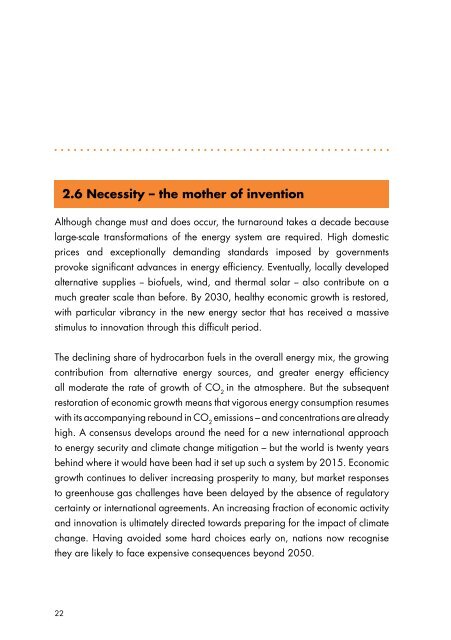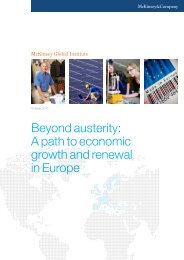Shell energy scenarios to 2050 - Manicore
Shell energy scenarios to 2050 - Manicore
Shell energy scenarios to 2050 - Manicore
You also want an ePaper? Increase the reach of your titles
YUMPU automatically turns print PDFs into web optimized ePapers that Google loves.
2.6 Necessity – the mother of inventionAlthough change must and does occur, the turnaround takes a decade becauselarge-scale transformations of the <strong>energy</strong> system are required. High domesticprices and exceptionally demanding standards imposed by governmentsprovoke significant advances in <strong>energy</strong> efficiency. Eventually, locally developedalternative supplies -- biofuels, wind, and thermal solar -- also contribute on amuch greater scale than before. By 2030, healthy economic growth is res<strong>to</strong>red,with particular vibrancy in the new <strong>energy</strong> sec<strong>to</strong>r that has received a massivestimulus <strong>to</strong> innovation through this difficult period.The declining share of hydrocarbon fuels in the overall <strong>energy</strong> mix, the growingcontribution from alternative <strong>energy</strong> sources, and greater <strong>energy</strong> efficiencyall moderate the rate of growth of CO 2in the atmosphere. But the subsequentres<strong>to</strong>ration of economic growth means that vigorous <strong>energy</strong> consumption resumeswith its accompanying rebound in CO 2emissions – and concentrations are alreadyhigh. A consensus develops around the need for a new international approach<strong>to</strong> <strong>energy</strong> security and climate change mitigation – but the world is twenty yearsbehind where it would have been had it set up such a system by 2015. Economicgrowth continues <strong>to</strong> deliver increasing prosperity <strong>to</strong> many, but market responses<strong>to</strong> greenhouse gas challenges have been delayed by the absence of regula<strong>to</strong>rycertainty or international agreements. An increasing fraction of economic activityand innovation is ultimately directed <strong>to</strong>wards preparing for the impact of climatechange. Having avoided some hard choices early on, nations now recognisethey are likely <strong>to</strong> face expensive consequences beyond <strong>2050</strong>.22



